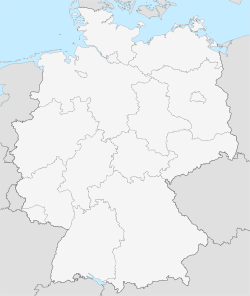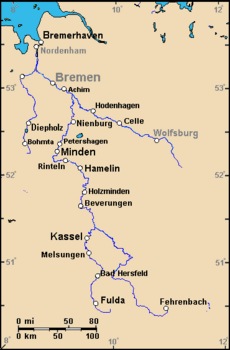Wilhelmshaven
| Wilhelmshaven | |
| Coat of arms | Location |
 |
 |
| Administration | |
| Country | Germany |
|---|---|
| State | Lower Saxony |
| District | Urban district |
| Lord Mayor | Eberhard Menzel (SPD) |
| Basic statistics | |
| Area | 106.91 km² (41.3 sq mi) |
| Elevation | 2 m (7 ft) |
| Population | 82,797 (30/12/2006) |
| - Density | 774 /km² (2,006 /sq mi) |
| Other information | |
| Time zone | CET/CEST (UTC+1/+2) |
| Licence plate | WHV |
| Postal codes | 26351–26389 |
| Area codes | 04421, 04423 und 04425 (jeweils teilweise) |
| Website | www.wilhelmshaven.de |

Wilhelmshaven (IPA: [vɪlhɛlmsˈhaːfən]) is a town in Lower Saxony, Germany. It is situated at the western coast of the Jadebusen, which is a bay of the North Sea. Population: 83,238 (2006).
Contents |
History
As early as 1383, the Sibetsburg castle existed, which was owned by pirates and destroyed in 1433 by the Hanseatic League. Four centuries later the Kingdom of Prussia planned a fleet and a harbour at the North Sea. In 1853, Prince Adalbert of Prussia arranged the Jade Treaty (Jade-Vertrag) with the Grand Duchy of Oldenburg, in which Prussia and the grand duchy entered into a contract: 3.13 km² of Oldenburgian territory at the Jadebusen should be ceded to Prussia. In 1869, Wilhelm I of Germany founded the town as part of the Province of Hanover for a naval base of Prussia's developing fleet. The duchy of Oldenburg benefited as well from the port; adjacent to Wilhelmshaven the town of Rüstringen was founded on the Oldenburgian territory. Wilhelmshaven and Rüstringen merged in 1937.
World War II
During World War II, Alter Bant Weg (No. 1582 Wilhelmshaven) was a subcamp of the Neuengamme concentration camp. From spring 1943 until November 1943 inmates of the SS-Baubrigade II from the Neuengamme camp were transferred to Wilhelmshaven and forced to clear up after air raids[1] (two thirds of the town's buildings were destroyed):
| Bombing of Wilhelmshaven during World War II | |||||
| Date | Description | ||||
|---|---|---|---|---|---|
| September 4, 1939 | Unsuccessful RAF bombing of Wilhelmshaven[2] | ||||
| December 18, 1939 | The first combat success of radar used a German "experimental Freya radar" to detect unescorted RAF bombers approaching the German Bight enroute to Wilhelmshaven - German fighters defeated the attack.[2] | ||||
| January 27, 1943 | 55 B-17 Flying Fortresses and B-24 Liberators of the 1st and 2nd Bomb Wings on the first WWII US mission flown against the German homeland bombed warehouses and industrial plants at Wilhelmshaven. 3 US bombers and 22 German fighters are shot down.[3] | ||||
| June 11, 1943 | VIII Bomber Command Mission Number 62: 252 B-17's are dispatched against the U-boat yard at Wilhelmshaven, Germany and the port area at Cuxhaven, Germany; 218 hit the targets; we claim 85-20-24 Luftwaffe aircraft; we lose 8 and 62 are damaged. Casualties are 3 KIA, 20 WIA and 80 MIA. The raid on Wilhelmshaven demonstrated the difficulty of operating beyond range of fighters escort as enemy fighters attacks prevent accurate bombing of the target.[4] | ||||
In September 1946 Operation Union allowed the married British servicemen and civilian members of the Occupation Forces to have their families join them in the occupied zones of Germany. With so many units scattered throughout the occupied zone, most areas did not have enough children to justify opening local schools. Many older children had no formal lessons for a year, until the opening of the first boarding school at Wilhelmshaven
Prince Rupert School (PRS) opened in July 1947 and is believed to be the first comprehensive, co-educational, boarding school under the terms of the 1944 Education Act. The school, for the children of the British Armed Forces and Control Commission personnel stationed in the British Zone of Germany, was situated in Wilhelmshaven. The site had originally been a German Naval submarine base for two Training Flotillas. At the end of the Second World War the site was occupied by the Royal Navy and called H.M.S. Royal Rupert. Subsequently, the Royal Navy vacated the site to allow it to be used as a school and formally handed it over on 1st July 1947, by the lowering of the White Ensign and the raising of the Union Jack.
The school continued in Wilhelmshaven until 1972 when it was moved to Rinteln.
On the 3rd September 2007 a memorial was dedicated in Wilhelmshaven on a corner of what was the school site. This was paid for by ex pupils and staff who wanted a permanent reminder of the times they had spent in Wilhelmshaven.[1]
Wilhelmshaven today
After the war the harbour was used not only for military purposes, but for economy and tourism as well. Today, Wilhelmshaven is the German navy's main base at the North Sea again. It is also the third largest German port (after Hamburg and the combined ports of Bremen and Bremerhaven) with mainly oil products being loaded and unloaded. Besides the military, chemical industries and a refinery are the main employers of Wilhelmshaven which has one of the highest unemployment rates in the western part of Germany. The oil terminal and the refinery are connected with other German industrial centres by pipelines. Wilhelmshaven also provides an Applied Sciences University (Fachhochschule) for engineering and business sciences.
Economic hopes rest in following major development projects:
- the JadeWeserPort project for a deep water container port to be constructed 2006 - 2010, able to berth even the largest container vessels presently under construction
- the construction of a 800 MW power plant; completion in year 2012
- the further development of the chemical industry
- the construction of an LNG-Terminal
- the proposed coastal highway (Küstenautobahn) connecting north-western German industrial centres at the Elbe, Weser, and Ems rivers.
Sights
-Aquarium Wilhelmshaven, an aquarium with native animals from the North Sea, the information centre of the Lower Saxony Wadden Sea National Park.
-The Deutsches Marinemuseum (Navy Museum), whose main exhibits are the former German Navy] destroyer Mölders (D186), a submarine, and some smaller warships as well as an exhibition of German naval history from the 19th century onwards.
-The Küstenmuseum (Coast Museum).
-As the town's landmark the Kaiser-Wilhelm-Brücke ("Emperor Wilhelm Bridge") is considered, which crosses an inlet of the Jadebusen. It was built in 1905 to 1907; with a length of 159 m it was once the greatest swing bridge of Europe.
-The Town Hall (Rathaus), a large brick building, constructed in 1927-1929 by the architect Fritz Höger as the town hall of the city of Rüstringen.
-The Christus-und-Garnisionskirche, the oldest church of the city. It was built in 1869 by the Prussian architect Friedrich Adler.
-Kaiser-Wilhelm-Denkmal at the Friedrich-Wilhelm-Platz, a monument errected in memory of emperor Wilhelm I of Prussia in 1896, who was one of the founder of the city. After the statue had been melted down in 1942, it was reconstructed in 1994.
-The entrance building of the former Kaiserliche Marinewerft ("emperor's shipyard"), built in the 1870ties.
-The building of the former Kaiserliche Westwerft ("emperor's western shipyard"), completed in 1913.
Twinned cities
 Vichy, France, since 1965
Vichy, France, since 1965 Norfolk, Virginia, U.S., since 1976
Norfolk, Virginia, U.S., since 1976 Dunfermline, Scotland, since 1979
Dunfermline, Scotland, since 1979 Qingdao, People's Republic of China, since 1992
Qingdao, People's Republic of China, since 1992 Bad Harzburg, Germany since 1988
Bad Harzburg, Germany since 1988 Bydgoszcz, Poland, since 2006
Bydgoszcz, Poland, since 2006
See also
- List of subcamps of Neuengamme
Notes
- ↑ List of working locations SS-Baubrigade II by the Memorial Neuengamme
- ↑ 2.0 2.1 Galland, Adolf (1968 Ninth Printing - paperbound). The First and the Last: The Rise and Fall of the German Fighter Forces, 1938-1945. New York: Ballantine Books. pp. 20,105.
- ↑ Lang, Name (199). Avenel NJ: Random House. p. p102,106. ISBN 0-317-16092-7.
- ↑ "8th Air Force 1944 Chronicles". Retrieved on 2007-05-25.October, December, January
References
- Official German list of concentration camps Verzeichnis der Konzentrationslager und ihrer Außenkommandos (German)
- Camp memorial Neuengamme (German)
|
|||||||||||